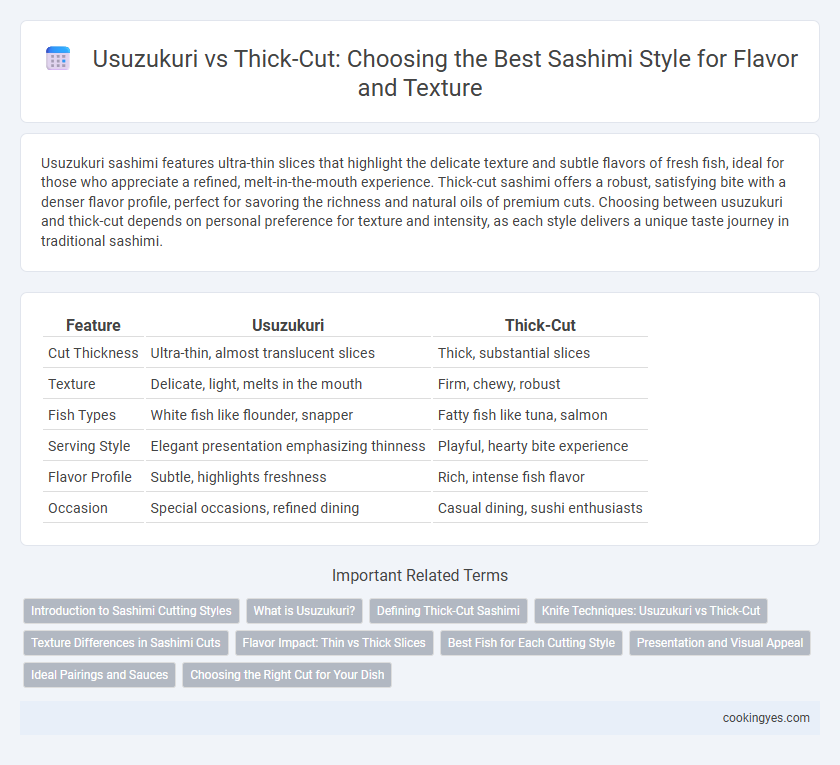Usuzukuri sashimi features ultra-thin slices that highlight the delicate texture and subtle flavors of fresh fish, ideal for those who appreciate a refined, melt-in-the-mouth experience. Thick-cut sashimi offers a robust, satisfying bite with a denser flavor profile, perfect for savoring the richness and natural oils of premium cuts. Choosing between usuzukuri and thick-cut depends on personal preference for texture and intensity, as each style delivers a unique taste journey in traditional sashimi.
Table of Comparison
| Feature | Usuzukuri | Thick-Cut |
|---|---|---|
| Cut Thickness | Ultra-thin, almost translucent slices | Thick, substantial slices |
| Texture | Delicate, light, melts in the mouth | Firm, chewy, robust |
| Fish Types | White fish like flounder, snapper | Fatty fish like tuna, salmon |
| Serving Style | Elegant presentation emphasizing thinness | Playful, hearty bite experience |
| Flavor Profile | Subtle, highlights freshness | Rich, intense fish flavor |
| Occasion | Special occasions, refined dining | Casual dining, sushi enthusiasts |
Introduction to Sashimi Cutting Styles
Usuzukuri sashimi features ultra-thin slices that highlight the delicate texture and subtle flavors of fresh fish, often served chilled for a refined dining experience. Thick-cut sashimi offers a more substantial bite, emphasizing the fish's rich, buttery taste and firm texture, ideal for those who prefer a heartier mouthfeel. Both cutting styles showcase the precision and skill of the chef, enhancing the visual appeal and taste profile of traditional Japanese sashimi.
What is Usuzukuri?
Usuzukuri is a sashimi technique characterized by paper-thin slices of fish, typically less than 2mm thick, enhancing the delicate texture and subtle flavors of fresh seafood like flounder or sea bream. Unlike thick-cut sashimi, which emphasizes a richer, more robust mouthfeel through thicker slices, usuzukuri allows for a light, almost translucent presentation that highlights the fish's natural sweetness and freshness. This style requires precise knife skills and is often served with ponzu sauce to complement its clean and refined taste.
Defining Thick-Cut Sashimi
Thick-cut sashimi features slices typically around 5-10 millimeters thick, emphasizing the rich texture and natural flavor of the fish. Unlike usuzukuri, which is paper-thin and delicate, thick-cut sashimi delivers a more pronounced mouthfeel and allows for a more substantial bite. Commonly prepared from fatty cuts like tuna akami or salmon, thick-cut sashimi highlights the fish's marbling and offers a satisfying contrast to the subtlety of usuzukuri.
Knife Techniques: Usuzukuri vs Thick-Cut
Usuzukuri sashimi requires precise, ultra-thin slicing techniques using a long, flexible yanagiba knife to create translucent, delicate fish slices, showcasing texture and subtle flavors. Thick-cut sashimi relies on heavier, more controlled knife pressure with a thicker blade to produce substantial, firm cuts that emphasize the fish's rich, robust taste and mouthfeel. Mastery in adjusting blade angle, slicing speed, and pressure distinguishes the usuzukuri's finesse from the bold, hearty presentation of thick-cut sashimi.
Texture Differences in Sashimi Cuts
Usuzukuri sashimi features ultra-thin slices that deliver a delicate, melt-in-the-mouth texture highlighting the fish's freshness and subtle flavors. Thick-cut sashimi provides a firmer, more substantial bite, emphasizing the meat's natural chewiness and deeper taste profile. These textural differences influence not only the sensory experience but also pairing options with soy sauce and wasabi.
Flavor Impact: Thin vs Thick Slices
Usuzukuri sashimi features ultra-thin slices that enhance delicate flavors and provide a tender, melt-in-the-mouth texture, allowing subtle nuances of freshness to shine. Thick-cut sashimi delivers a more robust taste and firmer bite, intensifying the natural umami and offering a satisfying chewiness that highlights the fish's richness. Choosing between usuzukuri and thick-cut depends on whether the preference leans toward refined subtlety or bold, concentrated flavor.
Best Fish for Each Cutting Style
Usuzukuri sashimi features paper-thin slices ideal for delicate fish like flounder and hamachi, highlighting their subtle texture and flavor. Thick-cut sashimi suits robust fish such as tuna and salmon, emphasizing a rich mouthfeel and pronounced taste. Selecting the best fish for each cutting style enhances the overall sashimi experience by balancing texture and flavor intensity.
Presentation and Visual Appeal
Usuzukuri sashimi features ultrathin slices that create an elegant, translucent presentation highlighting the fish's delicate texture and color. Thick-cut sashimi emphasizes boldness with chunky, substantial pieces that showcase the fish's marbling and richness, offering a visually robust appeal. The choice between usuzukuri and thick-cut style significantly impacts the sashimi's aesthetic, balancing subtle refinement against hearty vibrancy.
Ideal Pairings and Sauces
Usuzukuri sashimi, known for its ultra-thin slices of fish like flounder or tuna, pairs ideally with light, citrus-based ponzu sauce to enhance its delicate texture and subtle flavors. Thick-cut sashimi, often made from fatty salmon or yellowtail, complements rich, soy-based dipping sauces or spicy miso that emphasize its robust mouthfeel and pronounced taste. Choosing the right sauce not only balances the sashimi's thickness but also elevates the overall dining experience by highlighting specific flavor profiles.
Choosing the Right Cut for Your Dish
Usuzukuri sashimi features paper-thin slices of fish, highlighting delicate texture and subtle flavors, ideal for light dipping sauces and refreshing presentations. Thick-cut sashimi offers a more substantial bite with pronounced taste and a firmer mouthfeel, perfect for rich, flavorful fish like tuna or salmon. Selecting the right cut depends on the fish type and desired eating experience, balancing texture, flavor intensity, and presentation style.
Usuzukuri vs Thick-cut for sashimi style Infographic

 cookingyes.com
cookingyes.com